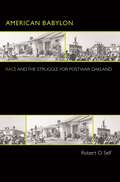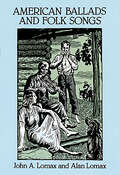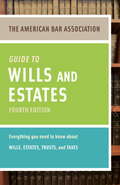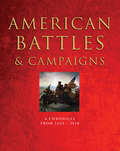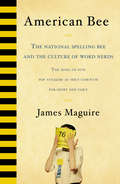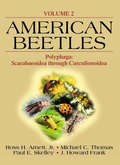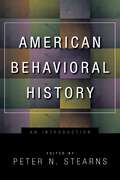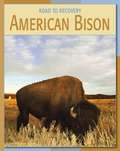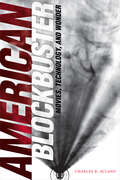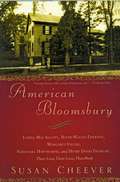- Table View
- List View
American Babylon: Race and the Struggle for Postwar Oakland (Politics and Society in Modern America #37)
by Robert O. SelfA gripping portrait of black power politics and the struggle for civil rights in postwar OaklandAs the birthplace of the Black Panthers and a nationwide tax revolt, California embodied a crucial motif of the postwar United States: the rise of suburbs and the decline of cities, a process in which black and white histories inextricably joined. American Babylon tells this story through Oakland and its nearby suburbs, tracing both the history of civil rights and black power politics as well as the history of suburbanization and home-owner politics. Robert Self shows that racial inequities in both New Deal and Great Society liberalism precipitated local struggles over land, jobs, taxes, and race within postwar metropolitan development. Black power and the tax revolt evolved together, in tension.American Babylon demonstrates that the history of civil rights and black liberation politics in California did not follow a southern model, but represented a long-term struggle for economic rights that began during the World War II years and continued through the rise of the Black Panthers in the late 1960s. This struggle yielded a wide-ranging and profound critique of postwar metropolitan development and its foundation of class and racial segregation. Self traces the roots of the 1978 tax revolt to the 1940s, when home owners, real estate brokers, and the federal government used racial segregation and industrial property taxes to forge a middle-class lifestyle centered on property ownership.Using the East Bay as a starting point, Robert Self gives us a richly detailed, engaging narrative that uniquely integrates the most important racial liberation struggles and class politics of postwar America.
American Ballads and Folk Songs (Dover Books on Music)
by John A. Lomax Alan LomaxWith this ample collection of authentic ballads and songs, you can immerse yourself in the rich tradition and heritage of American folk music. Discover the diversity, spontaneity, free-flowing melody, and sheer invention of scores of songs sung by cowboys and convicts, lumberjacks, hobos, miners, plantation slaves, mountaineers, soldiers, and many others.One of the remarkable features of this collection is its authenticity. Many of the songs were recorded "on location" by noted folklorist John A. Lomax and his even more famous son, Alan, as they traveled around the United States. The results are firsthand versions of music and lyrics for over 200 railroad songs, chain-gang songs, mountain songs, Creole songs, cocaine and whisky songs, "reels," minstrel songs, songs of childhood, and a host of others. Among them are such time-honored favorites as "John Henry," "Goin' Home," "Frankie and Albert," "Down in the Valley," "Little Brown Jug," "Alabama-Bound," "Shortenin' Bread," "Skip to My Lou," "Frog Went a-Courtin'," and a host of others. An excellent introduction, notes on each song, a bibliography, and an index round out this extensive and valuable collection.Musician, musicologists, folklorists, singers — anyone interested in American folk music — will welcome this treasury of timeless song gathered in one handy, inexpensive volume.
American Band
by Kristen LaineIn the spirit of Friday Night Lights comes the stirring story of a marching band from small-town middle America. Every fall, marching bands take to the field in a uniquely American ritual. For millions of kids, band is a rite of passage-a first foray into leadership and adult responsibility, and a chance to learn what it means to be a part of a community. Nowhere is band more serious than at Concord High School in Elkhart, Indiana, where the entire town is involved with the success of its defending state champion band, the Marching Minutemen. In the place where this tradition may have originated, in the city that became the band instrument capital of the world, band is a religion. But it's not the only religion-as legendary director Max Jones discovers when conflicting notions of faith and purpose collide during his final year as director. In this intimate chronicle, the band marches through a season that starts in hope and promise, progresses through uncertainty and disappointment, and ends, ultimately, in redemption.
American Bar Association Guide to Resolving Legal Disputes: Inside and Outside the Courtroom
by American Bar AssociationWhether you’re fighting with a neighbor about who should pay for a fence, pursuing a charge of discrimination at work, or chasing a $5000 loan, theABA Guide toResolving Legal Disputes: Inside and Outside the Courtroomcan help you decide what steps to take to resolve disputes. This book, written in easy-to-read language with dozens of real-life examples, includes tips on how to be a better negotiator. It also provides important information about mediation, arbitration, small claims court, and civil court procedures, and includes a chapter on working with a lawyer, with tips on how you can save time and money.
American Bar Association Guide to Wills and Estates, Fourth Edition
by American Bar AssociationThe American Bar Association Guide to Wills & Estates, Fourth Edition, is the user-friendly guide that contains everything you need to know about planning an estate and preparing a will. It is organized in easy-to-follow chapters with sidebars containing tips, checklists, and key information, encouraging you to begin the process quickly and easily.The ABA Guide to Wills & Estates will help you:* Determine what to put in an estate plan* Decide whether to prepare a will, trust, or living trust* Avoid or reduce estate taxes* Transfer property without a will with substitutes such as life insurance and joint tenancy* Understand the benefits of living gifts and life insurance, among many other topics The Fourth edition features new and updated topics, such as: * Life-threatening and chronic illnesses* Incorporating your religious beliefs into your estate plan * Assisted reproduction and its resulting estate planning implications* Civil unions and same-sex marriages* Elder abuse and care* Information about Roth IRAs in estate plans* The impact of digital assets on estate planning
American Barbecue Sauces: Marinades, Rubs, and More from the South and Beyond
by Greg MrvichKick up your cookout—barbecue sauces, marinades, and more from across the countryEvery barbecue master knows—the secret's in the sauce. American Barbecue Sauces is packed with savory recipes for bastes, glazes, mops, wet and dry rubs, marinades, condiments—and of course, sauces—from all over the United States. Fire up the grill!From Central Texas to Chicago, and Memphis to the Southwest and beyond, get to know America's barbecue belt with these explosively flavorful sauces and seasonings. Complete with classic favorites, creative concoctions, and a list of online resources that offer even more mouthwatering recipes, this book has everything you need to take your taste buds on a delicious road trip across the country.This saucy book includes:Barbecue basics—Discover details about American barbecue, including the big four BBQ regions, the five mother sauces, lesser-known BBQ styles, and more.Marinades, mops, and more—Explore other ways to heat up your barbecue game, with recipes like Cowboy Coffee Beef Rub, Basic Poultry Brine, and Old-Fashioned Glaze.Essential equipment—Convenient lists for stocking your kitchen include pantry items, necessary tools like basting brushes, and nice-to-haves like disposable gloves.Make your cookout really cook with tasty barbecue sauce recipes from the heart of America. Let's get cooking!
American Barns
by Jan ArnettThe heart of every working farm and ranch, the barn is an icon of rural America. This book chronicles - and celebrates - all the main types, and looks at how these treasures of early American architecture developed. It explains how a wealth of immigrant construction methods and range of environments and climates resulted in a fascinating variety of barn styles in the United States, from the earliest rare Dutch examples to simpler English types and others in more surprising shapes (round or even polygonal) crafted by the Shakers in the 1800s. It highlights the most notable, famous and historic barns that the reader can visit, and features highlights the efforts of conservation groups to preserve America's barns and find innovative ways to repurpose these glorious old structures as homes and studios--and as living monuments of rural heritage.
American Baroque: Pearls and the Nature of Empire, 1492-1700 (Published by the Omohundro Institute of Early American History and Culture and the University of North Carolina Press)
by Molly A. WarshPearls have enthralled global consumers since antiquity, and the Spanish monarchs Ferdinand and Isabella explicitly charged Columbus with finding pearls, as well as gold and silver, when he sailed westward in 1492. American Baroque charts Spain's exploitation of Caribbean pearl fisheries to trace the genesis of its maritime empire. In the 1500s, licit and illicit trade in the jewel gave rise to global networks, connecting the Caribbean to the Indian Ocean to the pearl-producing regions of the Chesapeake and northern Europe.Pearls—a unique source of wealth because of their renewable, fungible, and portable nature—defied easy categorization. Their value was highly subjective and determined more by the individuals, free and enslaved, who produced, carried, traded, wore, and painted them than by imperial decrees and tax-related assessments. The irregular baroque pearl, often transformed by the imagination of a skilled artisan into a fantastical jewel, embodied this subjective appeal. Warsh blends environmental, social, and cultural history to construct microhistories of peoples' wide-ranging engagement with this deceptively simple jewel. Pearls facilitated imperial fantasy and personal ambition, adorned the wardrobes of monarchs and financed their wars, and played a crucial part in the survival strategies of diverse people of humble means. These stories, taken together, uncover early modern conceptions of wealth, from the hardscrabble shores of Caribbean islands to the lavish rooms of Mediterranean palaces.
American Barrick Resources Corp.: Managing Gold Price Risk
by Peter Tufano Jon D. SerbinManaging the risk of changing prices of gold is central to the business strategy of American Barrick Resources Corp., one of North America's largest and most successful gold-mining firms. The case contrasts this firm's hedging policies with those of its rivals that do not hedge and details the wide range of hedging products (gold loans, forwards, options, spot deferred contracts) used to manage price risk. In 1992 the management of American Barrick is pleasantly surprised by unexpected new gold finds, but this new production places demands on the firm's hedging program and tests the firm's commitment to hedging when prices of gold and of many hedging vehicles are unattractive.
American Battles & Campaigns: A Chronicle from 1622-2010
by Chris McNabRaids and sieges; trench warfare and air campaigns; guerrilla warfare, naval engagements, and colonial wars—American Battles & Campaigns covers every major campaign and battle fought in North America or by United States’ forces overseas, from the Pequot War of 1634 to the recent conflicts in Afghanistan and Iraq. Arranged chronologically, American Battles & Campaigns: A Chronicle, from 1622-Present includes hundreds of entries, ranging from the 1770 Boston Massacre through the Alamo (1836) and the Philippine-American War (1899–1902), to Chateau-Thierry (1918), Midway (1942) and Hue (1969). Major battles, such as Yorktown, Gettysburg, Pearl Harbor, and D-Day, are illustrated with full-color annotated 3-dimensional maps and detailed text explaining the course of the engagement. Stuffed with black and white and color photographs, battle maps, paintings and other artwork, American Battles & Campaigns contains expert accounts and analysis from thirty leading military historians.
American Beauties: The Artwork of Harrison Fisher
by Harrison FisherHarrison Fisher's portraits of healthy, poised, active, and confident women set the standard of American beauty in the early 20th century -- and he enjoyed a celebrity status that was unparalled for an illustrator. This original publication compiles his very best black-and-white and color illustrations for Cosmopolitan, The Saturday Evening Post, books, and other publications.
American Bee: The National Spelling Bee and the Culture of Word Nerds
by James MaguireWhat the bestselling Word Freak did for Scrabble, this riveting narrative now does for the National Spelling Bee. Here is a captivating slice of Americana--part sporting event, part absorbing human drama, and part celebration of the magic of words. Every spring in the nation's capital, after a starting pool of 10 million kids narrows to 250 finalists, America's top young spellers face off in a nail-biting contest. So electric is the drama that millions of viewers tune in to watch ESPN's live telecastBut this national obsession is much more than a sporting story--and this first-ever narrative nonfiction book about the National Spelling Bee immerses the reader in unique subculture, portraying the endearing fraternity of brilliant, eccentric young word nerds who vie for a gold trophy, a hefty check, and a glorious moment of national fame.Author James Maguire, who like the contestants is an inveterate word nut, captures the agony and glory of this singularly American event. He profiles the top five spellers across the country, exploring their hopes and dreams-and strategies for winning--as they prepare for their moment in the spotlight. American Bee takes readers behind the scenes at the National Bee, providing a narrative thrill ride as the tension mounts round by round.
American Beetles, Volume I: Archostemata, Myxophaga, Adephaga, Polyphaga: Staphyliniformia
by Jr. Ross H. Arnett Michael C. ThomasA thorough update of Arnett's The Beetles of the United States, American Beetles, Volumes I and II cover the genera of beetles that occur in Alaska, Canada, and the contiguous United States. Built on the foundation of the original work and almost completely rewritten with contributions from more than 60 coleopterists, these volumes describe each fa
American Beetles, Volume II: Polyphaga: Scarabaeoidea through Curculionoidea
by J. Howard Frank Ross H. Arnett Michael C. Thomas Paul E. SkelleyExperts offer the most sweeping reference available on the subject of North American beetles. Their rigorous standards for the presentation of data create a concise, useful format that is consistent throughout the book. This is the resource of choice for quick, accurate, and easily accessible information.
American Behavioral History: An Introduction
by Peter N. StearnsFrom his founding of The Journal of Social History to his groundbreaking work on the history of emotions, weight, and parenting, Peter N. Stearns has pushed the boundaries of social history to new levels, presenting new insights into how people have lived and thought through the ages. Having established the history of emotions as a major subfield of social history, Stearns and his collaborators are poised to do the same thing with the study of human behavior. This is their manifesto. American Behavioral History deals with specific uses of historical data and analysis to illuminate American behavior patterns, ranging from car buying rituals to sexuality, and from funeral practices to contemporary grandparenting. The anthology illustrates the advantages and parameters of analyzing the ways in which people behave, and adds significantly to our social understanding while developing innovative methods for historical teaching and research. At its core, the collection demonstrates how the study of the past can be directly used to understand current behaviors in the United States. Throughout, contributors discuss not only specific behavioral patterns but, importantly, how to consider and interpret them as vital historical sources. Contributors include Gary Cross, Paula Fass, Linda Rosenzweig, Susan Matt, Steven M. Gelber, Peter N. Stearns, Suzanne Smith, Mark M. Smith, Kevin White.
American Biblical Archaeology and Zionism: The Politics of Objectivity from William F. Albright to William G. Dever
by Brooke Sherrard KnorrThis book examines the relationship between several of the most prominent American biblical archaeologists and Zionism. While these scholars have been studied and historicized to some extent, little work has been done to understand their role in the history of the Palestinian–Israeli conflict. Two defining differences in the archaeologists’ arguments were their understanding of culture and their views on objectivity versus relativism. Brooke Sherrard Knorr argues that relativist archaeologists envisioned the ancient world as replete with cultural change and opposed the establishment of a Jewish state, while those who believed in scholarly objectivity both envisioned the ancient world’s ethnic boundaries as rigid and favored Zionism. Combining readings of the archaeologists’ writings with archival research, this book studies the views of William Foxwell Albright, Millar Burrows, Nelson Glueck, George Ernest Wright, Paul Lapp, and William G. Dever regarding the establishment of an ethno-national state in Palestine in detail. The volume culminates with an epilogue commenting on the relevance of this topic in the present regarding the political ramifications of archaeology in the Israeli–Palestinian conflict. American Biblical Archaeology and Zionism is of interest to students and scholars of Biblical and Near Eastern archaeology, American religious history, and the Israeli-Palestinian conflict, particularly its role in regional archaeology.
American Big Business in Britain and Germany: A Comparative History of Two "Special Relationships" in the 20th Century
by Volker R. BerghahnWhile America's relationship with Britain has often been deemed unique, especially during the two world wars when Germany was a common enemy, the American business sector actually had a greater affinity with Germany for most of the twentieth century. American Big Business in Britain and Germany examines the triangular relationship between the American, British, and German business communities and how the special relationship that Britain believed it had with the United States was supplanted by one between America and Germany.Volker Berghahn begins with the pre-1914 period and moves through the 1920s, when American investments supported German reconstruction rather than British industry. The Nazi seizure of power in 1933 led to a reversal in German-American relations, forcing American corporations to consider cutting their losses or collaborating with a regime that was inexorably moving toward war. Although Britain hoped that the wartime economic alliance with the United States would continue after World War II, the American business community reconnected with West Germany to rebuild Europe’s economy. And while Britain thought they had established their special relationship with America once again in the 1980s and 90s, in actuality it was the Germans who, with American help, had acquired an informal economic empire on the European continent.American Big Business in Britain and Germany uncovers the surprising and differing relationships of the American business community with two major European trading partners from 1900 through the twentieth century.
American Biodefense: How Dangerous Ideas about Biological Weapons Shape National Security
by Frank L. Smith IIIBiological weapons have threatened U.S. national security since at least World War II. Historically, however, the U.S. military has neglected research, development, acquisition, and doctrine for biodefense. Following September 11 and the anthrax letters of 2001, the United States started spending billions of dollars per year on medical countermeasures and biological detection systems. But most of this funding now comes from the Department of Health and Human Services rather than the Department of Defense. Why has the U.S. military neglected biodefense and allowed civilian organizations to take the lead in defending the country against biological attacks? In American Biodefense, Frank L. Smith III addresses this puzzling and largely untold story about science, technology, and national security. Smith argues that organizational frames and stereotypes have caused both military neglect and the rise of civilian biodefense. In the armed services, influential ideas about kinetic warfare have undermined defense against biological warfare. The influence of these ideas on science and technology challenges the conventional wisdom that national security policy is driven by threats or bureaucratic interests. Given the ideas at work inside the U.S. military, Smith explains how the lessons learned from biodefense can help solve other important problems that range from radiation weapons to cyber attacks.
American Bison (North American Animals Ser.)
by Steve PottsAmerican bison live only in North America. Learn all about these grassland giants and their habitats in American Bison.
American Bison (Road to Recovery)
by Barbara A. SomervillThe American bison was hunted to near extinction in the 1800s as settlers moved west across what is now the United States. Readers will learn about this animal that is a symbol of the American West and find out what steps were taken to help increase the American bison population.
American Bison: A Natural History
by Dale F. LottThis book, sixth in the series of 'Organisms and environments', presents a peek at the rich and unique ways of life that evolved in the heart of America and dismantles many of the myths about these ways of life, and about the bison in particular, to reveal the animal itself: ruminating, reproducing, and rutting in its full glory. He portrays the bison with an element of appeal to conserve its wildness and consider the importance of the wild in our lives. A beautifully written book by a recognized expert on one of the great icons of the American West.
American Blockbuster: Movies, Technology, and Wonder (Sign, Storage, Transmission)
by Charles R. AclandBen-Hur (1959), Jaws (1975), Avatar (2009), Wonder Woman (2017): the blockbuster movie has held a dominant position in American popular culture for decades. In American Blockbuster Charles R. Acland charts the origins, impact, and dynamics of this most visible, entertaining, and disparaged cultural form. Acland narrates how blockbusters emerged from Hollywood's turn to a hit-driven focus during the industry's business crisis in the 1950s. Movies became bigger, louder, and more spectacular. They also became prototypes for ideas and commodities associated with the future of technology and culture, accelerating the prominence of technological innovation in modern American life. Acland shows that blockbusters continue to be more than just movies; they are industrial strategies and complex cultural machines designed to normalize the ideologies of our technological age.
American Bloods: The Untamed Dynasty That Shaped a Nation
by John Kaag"American Bloods is an unflinching history of our nation . . . This is a breakout book for John Kaag—the natural extension of his genre-defining writing.” —Doris Kearns Goodwin, Pulitzer Prize–winning author of Leadership: In Turbulent Times"Kaag has a knack of stumbling upon treasures . . . The result is a thrilling and illuminating tale." —John Banville, The New StatesmanA history of a family spanning centuries and continents—one that unfolds into a new portrait of America.The Bloods were one of America’s first and most expansive pioneer families. They explored and laid claim to the frontiers—geographic, political, intellectual, and spiritual—that would become the very core of the United States. John Kaag’s American Bloods is the account of a remarkable American family, of its participation in the making of a nation, and of how its members embodied the elusive ideals enshrined in the Declaration of Independence. Inspired by the discovery of a mysterious manuscript in an old Massachusetts farmhouse, Kaag follows eight members of this family from the British Civil Wars in the seventeenth century through the founding of the colonies, the American Revolution, transcendentalism, the Industrial Revolution, the Civil War, and the rise of first-wave feminism, all the way to the beginning of the twentieth century.The Bloods were active participants in virtually every pivotal moment in American history, coming into contact with everyone from Emerson and Thoreau to John Brown, Frederick Douglass, Victoria Woodhull, and William James. The genealogy of the family tracks the ebb and flow of what Thoreau called “wildness,” an original untamed spirit that would recede in the making of America but would never be extinguished entirely. American Bloods is an enduring reminder of the risks and rewards that were taken in laying claim to the lands that would become the United States, and a composite portrait of America like no other.
American Bloomsbury
by Susan CheeverEven the most devoted readers of nineteenth-century American literature often assume that the men and women behind the masterpieces were as dull and staid as the era's static daguerreotypes. Susan Cheever's latest work, however, brings new life to the well-known literary personages who produced such cherished works as The Scarlet Letter, Moby-Dick, Walden, and Little Women. Rendering in full color the tumultuous, often scandalous lives of these volatile and vulnerable geniuses, Cheever's dynamic narrative reminds us that, while these literary heroes now seem secure of their spots in the canon, they were once considered avant-garde, bohemian types, at odds with the establishment. These remarkable men and women were so improbably concentrated in placid Concord, Massachusetts, that Henry James referred to the town as the "biggest little place in America." Among the host of luminaries who floated in and out of Concord's "American Bloomsbury" as satellites of the venerable intellect and prodigious fortune of Ralph Waldo Emerson were Henry David Thoreau -- perpetual second to his mentor in both love and career; Louisa May Alcott -- dreamy girl and ambitious spinster; Nathaniel Hawthorne -- dilettante and cad; and Margaret Fuller -- glamorous editor and foreign correspondent. Perhaps inevitably, given the smallness of the place and the idiosyncrasies of its residents, the members of the prestigious circle became both intellectually and romantically entangled: Thoreau serenaded an infatuated Louisa on his flute. Vying with Hawthorne for Fuller's attention, Emerson wrote the fiery feminist love letters while she resided (yards away from his wife) in his guest room. Herman Melville was, according to some, ultimately driven mad by his consuming and unrequited affection for Hawthorne. Far from typically Victorian, this group of intellectuals, like their British Bloomsbury counterparts to whom the title refers, not only questioned established literary forms, but also resisted old moral and social strictures. Thoreau, of course, famously retreated to a plot of land on Walden Pond to escape capitalism, pick berries, and ponder nature. More shocking was the group's ambivalence toward the institution of marriage. Inclined to bend the rules of its bonds, many of its members spent time at the notorious commune, Brook Farm, and because liberal theories could not entirely guarantee against jealousy, the tension of real or imagined infidelities was always near the surface. Susan Cheever reacquaints us with the sexy, subversive side of Concord's nineteenth-century intellectuals, restoring in three dimensions the literary personalities whose work is at the heart of our national history and cultural identity.
